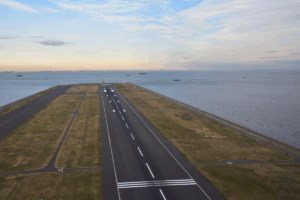Our customers often ask us what they can do to keep their airport lighting systems working efficiently while reducing maintenance calls and saving money over the long term.
In this month’s article, we thought we’d list three essential equipment maintenance tips and what to do if there is an issue with your system.
Perform Daily Visual Checks
Depending on an airport’s size, many jurisdictions may legally require airport and airstrip operators to conduct daily visual checks of their airport lighting equipment. This process includes turning the lights on to full intensity and looking for flickering or burnt-out lights along the taxiway, runway edge, runway, and LED precision approach path indicators (PAPI) as well as runway end identifier lights (REILs).
Many airport operators perform the visual check at 6 a.m. when natural light levels are optimum for this task in many parts of the world.
During the visual check, airport technicians must also ensure that the lights emit the same amount of light. If any are lighter, dimmer, brighter, or of a different color than the others, there’s an issue that needs to be addressed.
Some lights might also have misaligned, misdirected, or altogether missing lights that a snowplow, mower, or other heavy equipment may have knocked down. Many pieces of airport lighting technology include safety features if a light is misaligned. For example, PAPIs will automatically turn off if there’s an alignment issue with one or more of the light heads and alert technicians so the problem can be resolved.
Regular Cleaning And Maintenance of Your Airport Lighting Systems
Because of their location in wide open spaces, airport lighting systems are subjected to all kinds of abuse from nature, and become encrusted in dust, mud, bird excrement, and other substances that can negatively affect their visibility. We recommended cleaning the equipment whenever required using water and a non-abrasive soap that won’t scratch the lens, applied with a soft sponge.
Also, be sure to remove snow from the lens after a snowfall to ensure consistent lighting reliability, performance, and visibility.
Megger Testing
A megohmmeter sends voltage through a conductor and measures the resistance to current leakage in megohms. A low reading indicates degraded insulation, a loose connection, or other undesired paths to ground. The FAA suggests readings below 1 megohm indicate a circuit heading quickly toward failure. The location of undesired ground faults can be determined by testing each half of a faulty circuit, and then each half of the faulty section, and so on, until the fault is isolated.
Many constant current regulators (CCRs) have a screen that can tell you your amperage level, or you can use third-party tools to conduct Megger testing.
Cable damage from wildlife, wear and tear, or lightning strikes often cause low amperage. New cabling ,transformer, or connector kits should be installed as soon as possible to return your system to safe, reliable operation. Since the process can take several hours, many airports opt for Megger testing overnight.
Troubleshooting Your Airport Lighting Systems
If, during a visual check or cleaning, you discover that one or more of your lights isn’t operating correctly, there are some steps you can take to troubleshoot the issue before arranging for repair.
Refer To Your Owner’s Manual
The most crucial step is to check your owner’s manual for important safety information about your equipment. Manuals for Airport Lighting Company products are easily found on our website.
Count The Lights
Start by counting how many lights are affected. If more than one, take note of their position, e.g., are they right in a row, near one another, or on different ends of the runway? Depending on the size of your airstrip, as little as two lights out in a row can shut your airport down, so a fast response is critical in these cases.
Check The Lens And Bulb
Is the lens broken, cracked, scorched, or corroded? Has debris from the broken lens affected the lamp or light engine? Replace the affected parts with spares from your inventory or test with parts from an adjacent working light and turn the lights on again to see if that resolves the issue.
Inspect The Underground Fixture
If the problem is with a single light and its lens and lamp or light engine appear undamaged, the problem might be with the underground fixture. Never perform maintenance or repair on an energized circuit – it can be fatal. With the circuit de-energized using Lock out Tag out procedures, remove the top of the can and check the transformer and connector for loose connections, which often occur due to inadequate installation. Water freezing and thawing throughout the winter can pull the connectors even farther apart.
You can physically push the connections together again to create the circuit and try turning the lights on again to see if they’re now operational.
Make Records For Further Investigation
Record the serial numbers and the location of the lights that are out. When calling your service provider, the serial numbers will allow them to track who, where, and when the lights were made. This information can help them determine if there could be a manufacturing problem.
Call Airport Lighting Company For Technical Assistance
Feel free to call Airport Lighting Company if you’re unsure about why your lights or electrical system aren’t operational. Our technicians will help you get your airport lighting system up and running smoothly again. Call 315-800-9937 or toll-free at 1-866-212-1060 for fast, friendly support you can count on.


